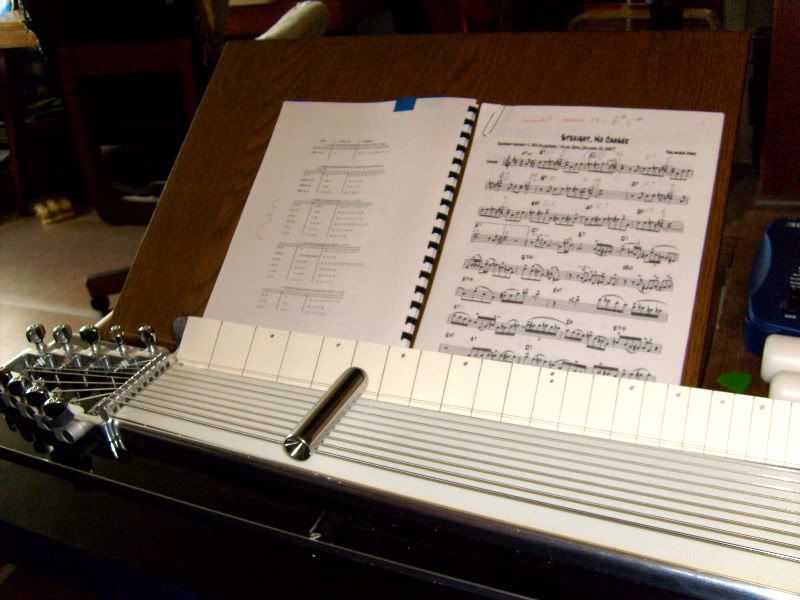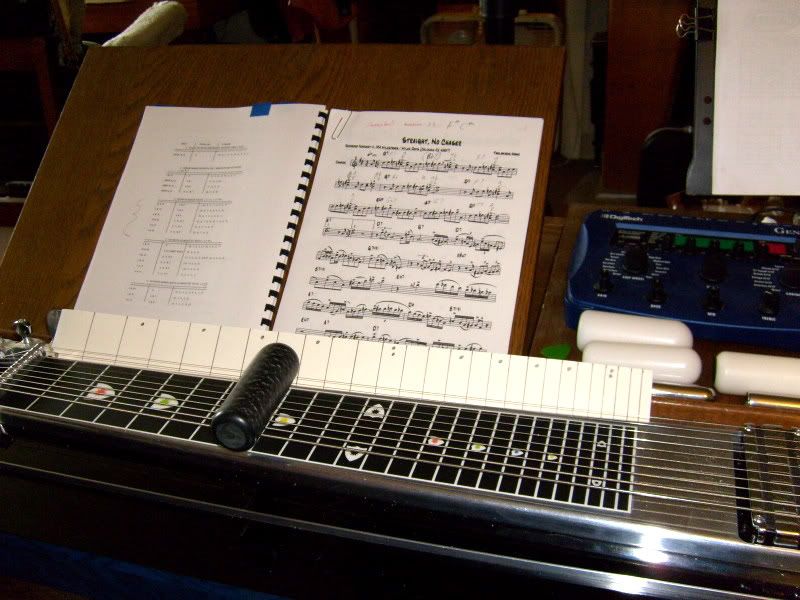| Author |
Topic: Fretboard Cheat Sheet |
W. Johnson
From:
Oregon, USA
|
 Posted 25 Oct 2015 8:11 am
Posted 25 Oct 2015 8:11 am |
|
| David Mason wrote: |
Well, there's NEVER an inappropriate moment to regurgitate the Hankey Upright Fretboard! to my eyes it's an easier visual leap to look above the nose of the bar than down through the strings. The original:

As you see, Mr. Hankey even forewent the usual fretboard at that point. My take on that:

But maskless is easy enough:

I've internalized whatever tuning-related frettiness there is to do with such a thing, but I guarantee it makes any attempt at reading sheet music-while-steeling mountains easier; and probably tab too, or even words if you're one of those singer-y types. Any way you can get the lines of music as close to the bottom of the stand helps too, like folding a printout in half etc. And it taught me that a white fretboard or overlay mixes with white-paper music better too - it's just less adjusting for your eyes to do and I need all the help I can with sheet music. With Mr. Johnson's mechanical aptitude this could be like a two-minute job, for sure. |
What a good idea, I'll have to try it.
Wayne
_________________
I am on Facebook as Innovative Guitars. Photos of all my work in photo album. I no longer make lap steels, but still make tone bars. |
|
|
 |
Daniel Nehring
From:
Michigan, USA
|
 Posted 25 Oct 2015 11:54 am
Posted 25 Oct 2015 11:54 am |
|
Here is another idea for learning the names of notes anywhere on the neck.
With regular guitar tuning, one learns to locate the I, IV, V bar chords using intervals and fret marker dots. For instance, in the key of E, the 5th fret is the A chord (IV) and the 7th fret is the B chord (V).
Looking at all the dotted frets for any string in any tuning, take the nut as the Root of the string your looking at. Then fret 3 is the minor third interval, fret 5 is 4th (subdominant), fret 7 is fifth (dominant), fret 9 is the sixth, and fret 12 is back to the Root.
If you know the note names of root, minor 3rd, 4th, 5th and 6th of each string in your tuning you will be able to quickly recall any of those dotted locations. When you have that, it's not hard to get the unmarked frets as sharps or flats of the nearest marked fret. Try randomly pointing at a string/fret location and calling out the name of the note. It gets easier the more you do it.
Dan |
|
|
 |
Stefan Robertson
From:
Hertfordshire, UK
|
 Posted 26 Oct 2015 2:26 am
Posted 26 Oct 2015 2:26 am |
|
| Daniel Nehring wrote: |
Here is another idea for learning the names of notes anywhere on the neck.
With regular guitar tuning, one learns to locate the I, IV, V bar chords using intervals and fret marker dots. For instance, in the key of E, the 5th fret is the A chord (IV) and the 7th fret is the B chord (V).
Looking at all the dotted frets for any string in any tuning, take the nut as the Root of the string your looking at. Then fret 3 is the minor third interval, fret 5 is 4th (subdominant), fret 7 is fifth (dominant), fret 9 is the sixth, and fret 12 is back to the Root.
If you know the note names of root, minor 3rd, 4th, 5th and 6th of each string in your tuning you will be able to quickly recall any of those dotted locations. When you have that, it's not hard to get the unmarked frets as sharps or flats of the nearest marked fret. Try randomly pointing at a string/fret location and calling out the name of the note. It gets easier the more you do it.
Dan |
Really great idea Dan.
This doesn't sound like a bad idea but then again Stickers help me always know what note i am playing while learning scales. I guess I am hoping that when I remove them muscle memory will take over.
_________________
Stefan
Bill Hatcher custom 12 string Lap Steel Guitar
E13#9/F secrets: https://thelapsteelguitarist.wordpress.com
"Give it up for The Lap Steel Guitarist" |
|
|
 |
Andy Henriksen
From:
Michigan, USA
|
 Posted 30 Nov 2015 1:14 pm
Posted 30 Nov 2015 1:14 pm |
|
This seems like as good a place as any to post this. I have started playing ukulele a bit more recently (love the portability of them, and the simplicity of 4 strings!) Anyway, this webpage has a pretty neat approach to learning the notes on the uke fretboard.
I would think some of the same concepts could be easily transferred to whatever steel tuning you use. For instance, starting with memorizing the open strings (I've made it this far!), and then the frets that have all natural notes only on them, e.g., frets 5 and 7 in C6 tuning. Anyway, I thought it was a neat approach, with some fun mnemonics, etc., that might be of interest to non-ukers.
http://lambchopukulele.blogspot.com/2010/05/how-to-learn-13-of-ukulele-fingerboard.html |
|
|
 |




